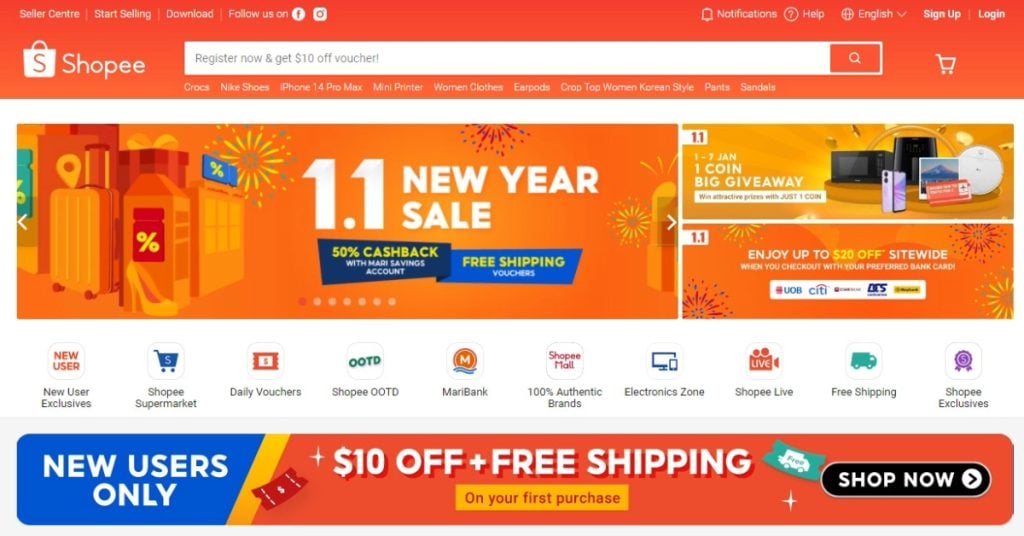
Shopee marketplace case study: book a demo to start yours
Shopee is a widely recognized e-commerce platform and mobile app, known for its extensive marketplace of circular fashion, second-hand, and beloved items, spanning across multiple countries in Southeast Asia and other areas. If you’d like to start your own marketplace like Shopee, you’re facing a buy vs build decision. So before you decide to build it in-house on top of Spree open-source, consider using the feature-rich Enterprise Edition cutting your time-to-market to a few weeks.
Build vs Buy a marketplace?
The use of open-source brings several advantages, such as total ownership and the ability to adapt as needed, but these benefits have their own costs. Developing a comprehensive marketplace solution is a lengthy, expensive endeavor, usually taking several months to years, as learned from various marketplace projects.
If you haven’t raised a significant amount of money, you’re much better off choosing a complete, off-the-shelf marketplace solution like Vendo, as advised by someone who has extensive experience in billing clients for marketplace development.
Back to the Shopee marketplace case study
Shopee, an e-commerce marketplace app, has experienced significant growth and transformation since its inception in 2015. Initially starting as a customer-to-customer marketplace similar to eBay, it has evolved into a B2C hybrid model, primarily serving the Southeast Asia region, along with East Asia and Latin America. This strategic shift has contributed to Shopee’s dominance in these regions, surpassing competitors like Amazon due to its low fees and gamification elements in its app, which include discounts and vouchers as prizes.
Owned by Sea Limited, Shopee’s 2022 performance highlights its success: generating $7.46 billion in revenue, a 63% increase from the previous year, and a gross merchandise volume of $73.5 billion. It had a staggering 375 million users, with its largest market in Indonesia accounting for 103 million of these users. The app’s popularity was further cemented with 215 million downloads in 2022.
However, the company’s journey has not been without challenges. In 2022, Shopee scaled back its operations in several countries, including Europe and parts of Latin America, as part of a cost-cutting measure.
Shopee’s marketing strategy is a crucial factor in its success. It employs a multi-channel approach, utilizing digital advertising, influencer marketing, promotions, discounts, user-generated content, and social media engagement to attract and retain a diverse customer base. A key part of their approach is the mobile-first strategy, acknowledging the high mobile internet usage in Southeast Asia. Over 95% of orders on Shopee are made via mobile, and the platform offers a comprehensive online shopping experience on its mobile app.
To cater to the diverse Southeast Asian market, Shopee adopts a hyper-localized approach, tailoring its product categories, marketing campaigns, and operational strategies to suit the specific needs of each country it operates in. For instance, in Indonesia, Shopee launched “Shopee Barokah” to offer Shariah-compliant products and services.
Innovation in customer experience is another pillar of Shopee’s strategy. The platform uses AI and AR technologies for personalization and engages users with features like Shopee Live, Shopee Games, and Shopee Feed. This approach fosters a community where users can interact and share their shopping experiences.
Furthermore, Shopee’s focus on enhancing customer experience through social features is evident in the introduction of new in-app features and the emphasis on supporting systems during major sales events. The company also invests in Shopee University, which provides training and support to brands and sellers, and introduces features that make the website more user-friendly.
How to emulate Shopee marketplace success?
To follow in the footsteps of Shopee’s success, think about quickly launching your marketplace, opting for weeks over months. Make sure your product catalog aligns with your audience’s preferences and continually adjust your methods for attracting customers, drawing on actual outcomes.
Test the market before making a full commitment to build it.
Here’s how to get started:
- Book a marketplace demo call: We’ll help you evaluate Spree for your marketplace needs and get started with the Enterprise Edition
- Customize your Storefront: Use the drag & drop page builder or custom CSS
- Onboard Brands: Invite your brands or choose brands from our catalog
- Select Products: Curate products and collections manually or automate it
- Embed products: Make your content, newsletters, social media shoppable
- Get Paid: Get paid as soon as products are shipped by the brands
- End-to-end automation: Brands sync, fulfillment, payouts, invoicing, taxes
When you’ve tried all that and it works, start thinking about building your own, custom-made marketplace project based on Spree Commerce. First, by decoupling the storefront and going headless with marketplace API, and later with your own backend, if you decide you really need it. Just lift and shift the storefront.
Nobody has to know what’s under the hood, right?



